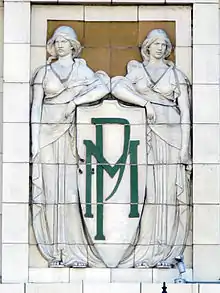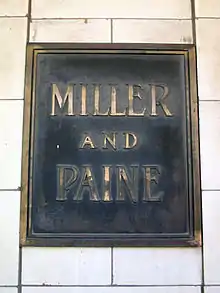Miller & Paine
Miller & Paine was a department store in Lincoln, Nebraska. Founded in 1880, Miller & Paine was acquired by Dillard's in 1988. Prior to the acquisition by Dillard's, Miller & Paine had three stores: two in Lincoln, the downtown flagship store and Gateway Mall with one in the Conestoga Mall in Grand Island, Nebraska. Miller & Paine was one of the first department stores in Lincoln.[1]
| Industry | Retail Department Store |
|---|---|
| Founded | 1880 |
| Founders | John Eschelman Miller and Dr. Bartlett Paine |
| Fate | Acquired in 1988 by Dillard's |
| Headquarters | Lincoln, Nebraska , US |
History

John Eschelman Miller arrived in Lincoln from Pennsylvania in 1879 and in 1880 formed a partnership with Dr. Bartlett Paine to build a department store at 13th and O streets in downtown Lincoln. The building was built in 1898.[2] The store was named Miller & Paine. In 1916, a new building was constructed on the site at 13th and O streets.[3] The new building was designed by Berlinghof & Davis.[4] In 1935, Miller & Paine became the first air-conditioned department store in Nebraska.

Miller & Paine had a lunch counter in the basement and the Tea Room on the fifth floor in the flagship downtown store. Besides having the tearoom and lunch counter, they also had a bakery that was famous for its cinnamon rolls and crumb cookies and made their own candy to sell in their candy department. Miller & Paine imported cinnamon for its trademark cinnamon rolls, and sharp English cheddar cheese for its macaroni & cheese which was served crusted in its own individual serving bowl. The company also owned a farm near Emerald, Nebraska for its own supply of poultry, vegetables and eggs.[1]
From 1917 to 1921, John Eschelman Miller, cofounder of Miller & Paine, served as the mayor of Lincoln, Nebraska.[5] In 1938, after the death of Miller, Robert Erle Campbell took over as chairman of the board of Miller & Paine, and from 1940 to 1941, he also served as Lincoln's mayor after being selected by the Lincoln City Council to fill a vacancy in the mayor's office.[6]
In 1960, Miller & Paine opened a store in the newly developed Gateway Mall in Lincoln as an anchor store and in 1974, Miller & Paine opened a store in the Conestoga Mall in Grand Island.
Miller & Paine sold their department stores in 1988 to Dillard's. The department stores ceased to use the name Miller & Paine re-branding the stores Dillard's. Shortly after the purchase, Dillard's closed the downtown store.
The company Miller & Paine continues to operate today as Miller & Paine LLC which operates properties in Lincoln, Nebraska.[7] The building designed by Berlinghof & Davis at 13th and O Streets is still in use as offices. The trademark Miller & Paine cinnamon rolls which were once served in the department store's tearooms continue to be produced and sold by the Lincoln, Nebraska-based fast food restaurant Runza, which purchased the rights to the recipe in 2007.[8]
References
- McKee, Jim (17 November 2013). "The rise and demise of Lincoln-owned department stores". Lincoln Journal Star. Retrieved 29 April 2015.
- "Miller & Paine Building". Lincoln Journal Star. Lincoln Journal Star. Retrieved 29 April 2015.
- "13th and O Streets looking West Lincoln Nebraska". Official Nebraska Government Website Nebraska Memories. Retrieved 29 April 2015.
- "UNL Historic Buildings". An Architectural Tour of Historic UNL. University of Nebraska. Retrieved 29 April 2015.
- "Tribute Is Paid By S. A. R. To Patriotic Work Of J. E. Miller". Lincoln Star. March 25, 1938. Retrieved April 1, 2023.
...John Eschelman Miller... [was] mayor of the city of Lincoln and... founder of the modern department store of Miller & Paine...
- "Miller & Paine Department Store Marks 60th Birthday". Nebraska State Journal. September 11, 1940. Retrieved April 1, 2023.
- "Robert E. Campbell". Equilar Atlas. Retrieved 29 April 2015.
- Korbelik, Jeff (9 June 2007). "Pederson makes magic with Miller & Paine cinnamon rolls". Lincoln Journal Star. Retrieved 30 November 2018.